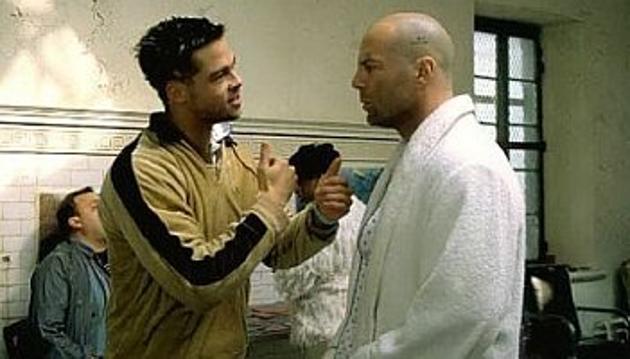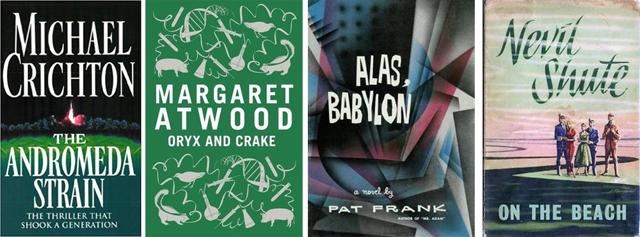HT’s pick of end of the world book and films
In pop culture, the end of the world has come through these scenarios- virus attacks, nuclear winters and natural disasters
In Independence Day, actor, Bill Pullman, as the US President, does an America-will-save-all speech as hostile extraterrestrials hover overhead. He tells his fighter pilots: “We’re going to live on! We’re going to survive!” The point of most end-of-the-world pop culture is that human beings will always prevail, though there may be bumps on the road like natural calamities, nuclear wars, ETs and contaminated monkeys carrying microbes potent enough to wipe off all humanity. Or, at least challenge it. We are thinking of apocalyptic scenarios today as the Coronavirus rages all over the world. Microbes and the various diseases, like the plague, caused by it, are, in fact, old literary and cinematic themes. They tap into societal fears of sudden deaths, death by contagion, of being reduced to a condition of total helplessness, where modern medicine, God or governments cannot effectively reach. The best of literature, however, explores what literary critic Frank Kermode called the “end-feeling”, i.e., “what it feels like those living in dangerous times, or while staring at destruction. Our pick of books and films show how human beings have coped in such situations:

Books
Station Eleven, 2014 Emily St John Mandel’s novel switches between the pre-flu world — a flu that wiped out almost all humanity — and Year Twenty after world collapse. The survivors, many of them artists, band together in an isolated colony. Kirsten, an actress, was eight when the flu hit. Twenty years later, she performs Shakespeare in the settlements that have come up since the collapse. “The more you remember, the more you’ve lost,” she says.
The Stand, 1978 Although most of Stephen King’s book focus on the survivors of a plague, the spread of the virus from the moment an experiment goes wrong in a government lab, gets good play. Campion, a soldier charged with security, treks across the country, spreading a trail of contamination and chaos. Censorship, martial law, all fail to contain the crisis. Is this how many democracies decay? King is prescient: “The President is dead, the Pentagon is for rent, nobody is debating anything in the House or the Senate except maybe for the termites and the cockroaches.”
The Andromeda Strain, 1969 During the Cold War, the threat from foreign viruses matched the US’s threat perception from the Soviets. This book by Michael Crichton follows on the heels of mankind’s first steps on the moon and mines the fear that the lunar expedition may have brought back unknown ills. The plot: a government satellite collecting space pathogens for use in biological warfare crashes in Arizona and its residents begin to die of a mysterious, contagious virus.
Alas, Babylon, 1959 In Pat Frank’s novel, electromagnetic strikes around the world have cut off a town. Its inhabitants undergo a meltdown. An Air Force officer sends his brother a telegram ending with “Alas, Babylon”, a code word for the impending end-time. A post-nuclear survival story, its moral seems to be that guns and weapons may give a sense of safety, but always stock up on butter and beans. And, of course, always believe in communal living; you’ll know who your friends are in times of crisis.

On the Beach, 1957 This is a world post World War III; the effects of a nuclear fallout are being felt everywhere. Nevil Shute sets his story primarily in an Australia when its government starts giving its people suicide pills. This bleak, chilling novel is alleviated by the evidence of human resilience: characters say carpe diem and enjoy the smallest of pleasures. A family plants a garden that they will never see.
Plague, 1947 In Oran, rats, unnoticed by the population, drop dead on the streets. When the main character, Dr Bernard Rieux’s friend dies, and more deaths ensue, it’s clear that there is an epidemic. The plague affects people in different ways. Cottard, a man who has reasons to fear the police, now becomes agreeable and tries hard to make friends. Another character, Tarrou, a good samaritan, thinks this is because he finds it easier to live with his own fears now that everyone else is in a state of fear, too. Albert Camus’s existential classic is about how human beings cobble up solidarity and courage in times of crisis.
The Scarlet Plague, 1912 Jack London’s story takes place in 2073, 60 years after the Red Death has wiped off the planet’s people. James Smith, one of the survivors, is quizzed by his grandsons who doubt his belief in “germs” because they cannot be seen. London’s take feels contemporary because the fear of pandemics is classic sci-fi territory that feeds off a very real fear of being struck down by a mysterious disease.
FILMS
Contagion 2011 Inspired by various pandemics such as the 2003 SARS and the 2009 flu epidemics, the film does a nice tracking job of who was patient zero: Beth Emhoff. Beth (Gwyneth Paltrow) comes in contact with a virus when she shakes hands with a chef who has handled a piglet infected with a mix of bat and pig viruses.
28 days later, 2002 In London, animal rights activists raid a lab and free chimpanzees undergoing experimentation. Scientists plead that the monkeys are infected with a virus called Rage, contagious by blood or bodily fluid, that will turn them into killers. The image of Cillian Murphy, who plays a hospital patient, walking through a deserted city where the killers have gone on a rampage is one of the most representative images of this chiller.
3 I am Legend, 2007 Will Smith as an army virologist is up against the Dark Seekers, cannibalistic mutants, who have already wiped off half of humanity. Smith’s daily quest, as he lives among Manhattan’s ruins, is to find people immune to the virus. By the end of the film, he hits upon the potential cure, which is delivered to Army officers by some survivors, and saves America, and thus all humanity, from chaos.

12 Monkeys, 1995 All that the protagonist, Bruce Willis’s James Cole, sees are “dead people”. Labelled a crazy by the State for his end-of-the-world ravings in the year 2035, he is forced to time travel back to prevent a plague. Waking up in 1990, he tells a panel of psychiatrists, “How can I save you? This already happened. I can’t save you. Nobody can.”
Outbreak, 1995 Dustin Hoffman plays an army doctor who leads a group of scientists to find a cure to find the monkey that is the source of the fictional and fierce Motaba virus that is threatening the US. His boss has other plans. Donald Sutherland aces in a nasty role as the face of the US military that created and wants to protect the virus as a biological weapon.






